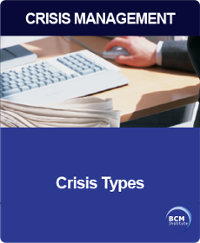 Crisis Scenario Due to Confrontation
Crisis Scenario Due to Confrontation
Here is another type of crisis scenario described in the "What Crisis or Crisis Scenario Should I Be Planning For My Organisation?" that is on the list to handle as part of crisis management and crisis communication. Click icon on the right to read more.
Introduction
In today's socially connected and highly scrutinised environment, organisations are increasingly vulnerable to crisis confrontations.
These crises occur when individuals or groups—such as employees, unions, activist organisations, customers, or community members—challenge the organisation’s actions or values through direct and often public means.
Whether through protests, strikes, or public backlash, such confrontations can quickly escalate, disrupting operations and damaging brand reputation.
Organisations that fail to anticipate or manage confrontational scenarios risk not only operational disruption but also long-term erosion of stakeholder trust.
Often, these confrontations stem from unresolved grievances, poor communication, or a perceived lack of accountability.
The following table outlines common examples of confrontation crisis scenarios, highlighting the types of challenges organisations may face and offering insight into how such events can unfold across different operational contexts.
Definition: Crisis Scenario – Confrontation
Crisis Scenario: Confrontation refers to a situation where an organisation faces direct opposition, conflict, or aggressive actions from individuals, groups, or stakeholders.
These confrontations may arise due to dissatisfaction with organisational decisions, perceived injustice, policy disagreements, or social and political grievances.
The confrontation can be physical (e.g., protests, sit-ins, strikes) or non-physical (e.g., public campaigns, legal threats), often escalating into a crisis if not addressed swiftly and effectively.
Type of Confrontation Crisis
 The standard type of confrontation crisis arises when employees:
The standard type of confrontation crisis arises when employees:
- Fight amongst themselves.
- Individuals often disagree with each other and eventually resort to nonproductive acts, such as boycotts and strikes, for prolonged periods.
- As employees disobey their superiors.
- Give them ultimatums and force them to accept their demands.
These crises are usually internal disputes resulting from ineffective communication and a lack of coordination, which often lead to confrontation crises.
Response to Confrontation Events
The key to managing such crises is to:
- Respond thoughtfully and acknowledge your role in the matter; and
- Manage all communication platforms, including social media accounts, carefully during the crisis.
Listen and Manage
It is essential to note that ignoring strong public digital voices is no longer an option. Companies have to learn to communicate effectively in the social media age, truly listen to social chatter, and respond in a way that aligns with both brand and customer expectations.
Everybody makes mistakes. However, having a solid crisis management and crisis communication plan in place to address the negative publicity or complaints promptly and transparently will not only help preserve the organisation's reputation.
Yet again, this enables the organisation to confirm that it is a business that cares about its stakeholders and is willing to go the extra mile to have happy stakeholders who are proud to be associated with the brand and live up to its values and ethics.
Example of Crisis Scenario: Confrontation
a list of examples for the crisis scenario: Confrontation, which typically involves disputes, conflicts, or aggressive behaviour directed at an organisation or its personnel, often leading to disruption of operations, reputational harm, or even safety concerns.
| No. | Example | Description |
|---|---|---|
| 1 | Industrial Strike or Labour Protest | A coordinated work stoppage by employees or union members demanding better wages, working conditions, or benefits. |
| 2 | Disruptive Employee Walkout | A group of employees stage a walkout in protest of management decisions or organisational policies. |
| 3 | Hostile Customer Protest | A large group of dissatisfied customers or activists organises a protest outside branches or corporate offices. |
| 4 | Activist Group Occupation | Environmental or social activists occupy company premises to demand changes in corporate practices. |
| 5 | Physical Altercation on Premises | A confrontation between customers, staff, or visitors escalates into violence, posing a threat to safety. |
| 6 | Boardroom Dispute or Executive Fallout | A publicised internal power struggle or resignation among senior leadership, causing loss of confidence. |
| 7 | Regulatory or Political Confrontation | Confrontation with government agencies over non-compliance or controversial policy issues. |
| 8 | Social Media Backlash Escalation | Online confrontations escalate into real-world protests, boycotts, or targeted harassment. |
| 9 | Community vs. Corporate Dispute | Local communities resist the company's expansion plans, construction projects, and land acquisitions. |
| 10 | Customer Threat or Harassment | A disgruntled customer issues threats or harasses staff, requiring law enforcement involvement. |
| 11 | Union Picketing and Blockades | Labour unions block access to company facilities, disrupting daily operations. |
| 12 | Cyber Harassment or Threat Campaign | A coordinated campaign of doxxing, threats, or hacking by activist groups or individuals. |
| 13 | Legal Confrontation by Former Staff | Ex-employees file lawsuits or publicly accuse the organisation of wrongful dismissal or discrimination. |
| 14 | Internal Whistleblower Conflict | An insider publicly reveals unethical behaviour, sparking internal and external confrontations. |
| 15 | Vendor or Partner Contract Dispute | Key suppliers or partners threaten legal or operational action over unresolved disputes. |
Conclusion
Effectively managing a confrontation crisis requires a balanced approach—one that combines clear communication, stakeholder engagement, and conflict de-escalation strategies.
Leaders must be prepared to listen, respond transparently, and act swiftly to prevent escalation. Failing to acknowledge and address the root causes of a confrontation can intensify the crisis and lead to lasting reputational and operational damage.
Proactive planning, including scenario testing, crisis communication frameworks, and employee relations protocols, can significantly improve an organisation’s readiness.
By recognising common confrontation triggers and preparing thoughtful response strategies, organisations can protect their people, preserve public trust, and maintain business continuity in the face of dissent or disruption.
More Information About Crisis Management Blended/Hybrid Learning Course
To learn more about the course and schedule, click the buttons below for the CM-300 Crisis Management Implementer [CM-3] and the CM-5000 Crisis Management Expert Implementer [CM-5].







![[BL-CM] [5] Register](https://no-cache.hubspot.com/cta/default/3893111/82024308-16f4-4491-98be-818a882c6286.png)

![Email to Sales Team [BCM Institute]](https://no-cache.hubspot.com/cta/default/3893111/3c53daeb-2836-4843-b0e0-645baee2ab9e.png)




![Banner [BL-5-Catalog] What Expert Level Blended Learning Courses that are Available?](https://no-cache.hubspot.com/cta/default/3893111/f39d2d89-53b2-4f11-982f-dd3462f224ac.png)
![[BL-3-Catalog] What Specialist Level Blended Learning Courses that are Available?](https://no-cache.hubspot.com/cta/default/3893111/1073197e-c1bd-47d3-97dc-32e7533619b7.png)

